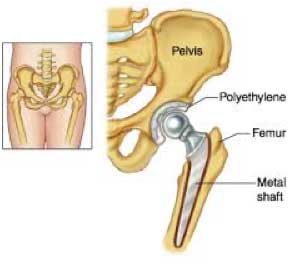Total Hip Replacement (Arthroplasty)–Includes Implants & Hardware
Total Hip Replacement (Arthroplasty)
During a Hip Replacement, a surgeon removes the damaged sections of your hip joint and replaces them with parts usually constructed of metal and very hard plastic. This artificial joint (prosthesis) helps reduce pain and improve function. Also called total Hip Arthroplasty, Hip Replacement Surgery may be an option for you if your hip pain interferes with daily activities and more-conservative treatments haven’t helped. Arthritis damage is the most common reason to need a Hip Replacement.

FAQS
Frequently asked questions about surgical procedures
Can I use my insurance and get these prices?
Payment is due 14 calendar days prior to your surgery date. If, after the cutoff, your account is not settled, your case must be postponed.
How quickly can I have surgery?
How will I meet my surgeon?
If I had a car or work accident, would you work with my employer or attorney for payment?
What if I get sick right before my surgery?
You could develop a respiratory infection, a urinary tract infection, COVID, or some other condition that may necessitate postponement. There is no penalty when this happens.
What’s Included:
- Facility fee
- Graft and hardware costs (if needed)
- Surgeon and assistant surgeon fees
- Anesthesiologist
- Time in the recovery unit (at no additional charge)
- Initial consultation visit
- One post-operative visit
*Please note: If you choose not to proceed with surgery after the initial consultation, or if you delay your procedure for more than 6 weeks, you will need to update your consultation at a cost of $375.
What’s not included:
- Lab testing before and after the surgery, as needed
- Electrocardiogram (EKG), depending on age. If you had one elsewhere in the past 6 months and it read “normal”, we can forego this expense.
- Imaging costs. X-rays and MRIs can be obtained anywhere.
- Physical therapy services
- Medications you’ll need (oral or IV antibiotic infusions if an infection arises)
- Wound care
- Bracing supplies
- Additional doctor visits (a pre-operative visit with the surgeon, in person, and any required post-op follow-ups after the suture removal to monitor your progress
- Additional surgical intervention if a complication arises
- Additional imaging or hospital care if a blood clot develops
How to Prepare for Surgery
People can do many things before their Hip Replacement Surgery to make everyday tasks easier and help speed up their recovery:
- Blood work, medical evaluation, chest x-ray, and an EKG, depending on your age and medical condition.
- Since there can be some blood loss during Hip Replacement surgery, you may need a blood transfusion, so you may want to consider donating your own blood before the procedure.
- Learn what to expect. Request information written for patients from the doctor.
- Arrange for someone to help you around the house for a week or two after coming home from the hospital.
- Arrange for transportation to and from the hospital. Set up a “recovery station” at home.
- Place the television remote control, radio, telephone, medicine, tissues, wastebasket, and water pitcher and glass next to the spot where you will spend the most time while you recover
- Place items you use every day at arm’s level to avoid reaching up and bending down.
- Stock up on kitchen supplies and prepare food in advance, such as frozen casseroles or soups that can be reheated and served easily.
Hip Replacement Surgical Procedure
Hip Replacement Surgery can be performed traditionally or by using what is considered a minimally invasive technique. The main difference between the two procedures is the size of the incision. During standard Hip Replacement Surgery, you are given general anesthesia to relax your muscles and put you into a temporary deep sleep. This will prevent you from feeling any pain during the surgery or having any awareness of the procedure. A spinal anesthetic may be given to help prevent pain as an alternative. The doctor will then make a cut along the side of the hip and move the muscles connected to the top of the thighbone to expose the hip joint. Next, the ball portion of the joint is removed by cutting the thighbone with a saw. Then, an artificial joint is attached to the thighbone using either cement or a special material that allows the remaining bone to attach to the new joint. The doctor then prepares the surface of the hipbone — removing any damaged cartilage — and attaches the replacement socket part to the hipbone. The new ball part of the thighbone is then inserted into the socket part of the hip. A drain may be put in to help drain any fluid. The doctor then reattaches the muscles and closes the incision.
What to expect after your surgery
Hip Replacement Recovery
You will be allowed only limited movement immediately after Hip Replacement Surgery.
- When you are in bed, pillows or a special device are usually used to brace the hip in the correct position.
- You may receive fluids through an intravenous tube to replace fluids lost during surgery.
- There also may be a tube located near the incision to drain fluid, and a type of tube called a catheter may be used to drain urine until you are able to use the bathroom.
- The doctor will prescribe medicine for pain or discomfort.
On the day after surgery or sometimes on the day of surgery, therapists will teach you exercises to improve recovery. A respiratory therapist may ask you to breathe deeply, cough, or blow into a simple device that measures lung capacity. These exercises reduce the collection of fluid in the lungs after surgery. As early as 1 to 2 days after surgery, you may be able to sit on the edge of the bed, stand, and even walk with assistance.
While you are still in the hospital, a physical therapist may teach you exercises such as contracting and relaxing certain muscles, which can strengthen the hip. Because the new, artificial hip has a more limited range of movement than a natural, healthy hip, the physical therapist will also teach you the proper techniques for simple activities of daily living, such as bending and sitting, to prevent injury to your new hip.
Helpful Tips Following Hip Replacement Surgery
- Follow the doctor’s instructions.
- Work with a physical therapist or other health care professional to rehabilitate your hip.
- Wear an apron for carrying things around the house. This leaves hands and arms free for balance or to use crutches.
- Use a long-handled “reacher” to turn on lights or grab things that are beyond arm’s length.
Hip Replacement Surgery Risks
Hip replacement surgery has been performed for years, and surgical techniques are being improved all the time. As with any surgery, however, there are risks.
Since you will not be able to move around much at first, blood clots are a particular concern. Your doctor will give you blood thinners to help prevent blood clots from occurring.
Infection and bleeding are also possible, as are risks associated with using general anesthesia.
Other less common concerns that you and your doctor must watch out for are:
- Your legs may not be of equal length after the surgery.
- You must be careful not to cross your legs or not to sit too low because the joint may be dislocated.
- Pieces of fat in the bone marrow may become loose, enter the bloodstream, and get into the lungs, which can cause very serious breathing problems.
- Nerves in the hip area may be injured from swelling or pressure, and can cause some numbness.
- Infection
Can I Travel to St George for Surgery?
Yes, and we’ll help you make all your arrangements.
- We have arrangements to try to obtain free flights through a non-profit volunteer pilot organization. We can do this with 10 days’ advance notice in most cases.
- We have discount codes for the Holiday Inn in town. This hotel is 1.5 miles from the surgery center and 2 miles from our clinic.
- We’ll arrange to send your after-surgery medications to your hometown pharmacy for pickup before you leave.
What if I would rather drive to St George?
No problem, we can help with those plans as well. When you have surgery with us, we’ll need to make sure you’re safe and comfortable after surgery. We’ll arrange cold compression therapy that requires an AC/DC adaptor/transformer and frequent stops to stretch and refill the ice reservoir on the road.
We’ll ask about the vehicle you’ll travel in to ensure you have a way to elevate and stretch out in the vehicle on the road while someone else does the driving.

How are follow-up and initial consultations handled?
In-person and telehealth consultations are possible with the surgeon to whom your case is assigned. The initial visit is included in the surgical package and is valued at $375.
We can also obtain the flights from the volunteer pilot nonprofit if you’d like to come for initial and follow-up visits in person. One follow-up visit is included in the surgical package at a value of $175. Any additional visits are charged at the time of service to your credit or debit card.
Transparent Pricing Guide
Find out the exact cost of your procedure in seconds, with no hidden fees, no surprises, and complete transparency every step of the way.
